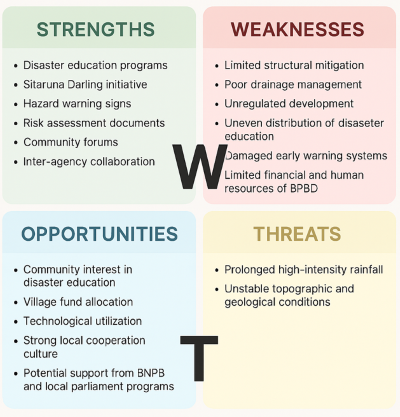Evaluation of Landslide Disaster Management in Sawahlunto
DOI:
https://doi.org/10.24036/cived.v12i1.737Keywords:
Landslide, Disaster Management, SWOT Analysis, Thematic Analysis, Risk Reduction StrategyAbstract
Sawahlunto City had a high level of landslide vulnerability due to its hilly topography with steep slopes and clay-dominated sedimentary geological conditions. These characteristics made the area highly susceptible to prolonged heavy rainfall, which acted as the main trigger for landslides. In response, the Regional Disaster Management Agency (BPBD) of Sawahlunto implemented disaster management efforts in the pre-disaster, during-disaster, and post-disaster phases. To evaluate the effectiveness, strengths, and weaknesses of these efforts, an evaluation was conducted along with the formulation of alternative strategies for landslide disaster risk reduction. This study employed a qualitative approach, based on interviews with 26 respondents, including relevant agency representatives and affected community members. A SWOT analysis was used to evaluate disaster management activities by identifying internal (strengths and weaknesses) and external (opportunities and threats) factors. The data were analyzed using thematic analysis to identify key themes based on similarities in the respondents’ statements. The results indicated several strengths, including disaster education programs, the Sitaruna Darling initiative, hazard warning signs, risk assessment documents, community forums, and inter-agency collaboration. Weaknesses included limited structural mitigation, poor drainage management, unregulated development, uneven distribution of disaster education, gaps in the formation of Disaster Resilient Villages, damaged early warning systems, and limited financial and human resources of BPBD. Opportunities involved community interest in disaster education, village fund allocation, technological utilization, a strong local cooperation culture, and potential support from BNPB and local parliament programs Major threats included prolonged high-intensity rainfall, unstable topographic and geological conditions prone to landslides, and low public understanding of landslide disaster risks. The recommended strategies involved enhancing inter-agency synergy, optimizing structural mitigation, strengthening regulations, ensuring equal access to disaster education, developing Sitaruna Darling innovations, improving early warning systems, and utilizing BNPB grants for recovery efforts.
Downloads
References
A. Asoka, W. Samry, Z. Zubir, dan Zulqayyim, SAWAHLUNTO DULU, KINI DAN ESOK : Menjadi Kota Wisata tambang yang Berbudaya, Edisi Pert. Sawahlunto: LPTIK Unand, 2016.
BPBD Kota Sawahlunto, “Dokumen kajian risiko bencana (krb) kota sawahlunto.”
BPS Kota Sawahlunto, “Banyaknya Kejadian Bencana Alam di Kota Sawahlunto 2019-2022.” 2022.
F. Friska, K. Kusdarini, dan R. E. Putera, “Upaya Pengurangan Risiko Bencana Tanah Longsor Melalui Implementasi Program Pengembangan Desa Tangguh Bencana Di Kota Sawahlunto,” JIPAGS (Journal Indones. Public Adm. Gov. Stud., vol. 5, no. 2, 2021, doi: 10.31506/jipags.v5i2.9498.
Direktorat Pelindungan Kebudayaan, “UNESCO Tetapkan Sawahlunto Sebagai Warisan Dunia,” Kebudayaan.Kemdikbud.Go.Id, no. July, 2019.
A. Andriani, B. Istijono, Alfito, F. Akmal, dan B. M. Adji, “Identification of Landslide Hazard in Residential Area Kubang Tangah District, Sawahlunto,” J. Appl. Eng. Technol. Sci., vol. 5, no. 2, hal. 1154–1164, 2024, doi: 10.37385/jaets.v5i2.3893.
I. G. N. A. Wiswasta, I. A. A. Agung, dan I. M. Tamba, Analisis SWOT (Kajian Perencanaan Model, Strategi, dan Pengembangan Usaha). 2018.
H. Umar, “Manajemen Strategik (Konsep dan Analisis),” Ilmu Sos. dan Ilmu Polit. Univ. Prof. Dr. Moestopo Beragama, vol. 5, no. 1, hal. 100, 2020.
Ben Wisner, J.C Gaillard, dan Ilan Kelman, Handbook of Hazards and Disaster Risk Reduction. 29 Maret 20212, 2012.
UNDRR, “Ecosystem-Based Disaster Risk Reduction: Implementing Nature -based Solution for Resilience,” United Nations Off. Disaster Risk Reduct. – Reg. Off. Asia Pacific, hal. 1–64, 2020.
U. N. O. for D. R. R. (UNDRR), “Global assessment report on disaster risk reduction 2019.” [Daring]. Tersedia pada: https://www.undrr.org/publication/global-assessment-report-disaster-risk-reduction-2019
UNDRR, “Sendai Framework For Disaster Risk reduction,” vol. 144, no. 2, hal. 169–173, 2015.
BNPB, “PERKA BNPB No.1/2012 - pedoman umum desa kelurahan tangguh bencana,” vol. 66, no. 1, hal. 1–47, 2012, [Daring]. Tersedia pada: https://www.bnpb.go.id/uploads/24/peraturan-kepala/2012/perka-1-tahun-2012-tentang-pedoman-umum-desa-dan-kelurahan-tangguh-bencana.pdf
D. E. Alexander, “Social Media in Disaster Risk Reduction and Crisis Management Social Media in Disaster Risk Reduction and Crisis Management,” no. October, 2014, doi: 10.1007/s11948-013-9502-z.
R. I. Presiden, Undang Undang RI Nomor 6 tahun 2014 Tentang Desa, vol. 18-April-2, no. 1. 2014, hal. 45–54. doi: 10.1145/2904081.2904088.
Badan Penangulangan Bencana Daerah Provinsi Banten, “Rencana Penanggulangan Bencana Provinsi Banten 2023-2027,” BPBD Provinsi Banten. 2023.

Downloads
Published
How to Cite
Issue
Section
License
Copyright (c) 2025 Diana Dwi Syafira, Taufika Ophiyandri, Benny Hidayat

This work is licensed under a Creative Commons Attribution 4.0 International License.







2.jpg)
